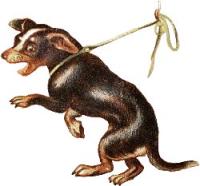
Should I Train my Puppy with a Pinch Collar?
You are wondering about pinch collars and whether you should use them
to train your puppy, itís a valid question. There is a lot of
controversy as to whether this type of training is the best choice.
Here are a few facts to help you decide.
Pinch collars, often called prong collars, are metal collars that have
blunt metal prongs around the inside of the collar. The prongs are
designed to poke the dogís skin when the collar is pulled tight,
without actually injuring the dog. Some people opt for collars with
plastic prongs on the inside, but these are not proven to be as
effective.
This type of training works through negative consequence behavior
training. The basic idea is that if your dog is doing a behavior that
is undesirable, a quick painful correction is a quick way to get the
dog's attention and stop the behavior. This technique is usually most
effective when you are trying to train a dog to walk correctly on the
leash because it gives him immediate consequences for trying to pull
ahead.
One of the reasons pinch collar training is so controversial is that
there is a possibility of hurting your pet if you donít use the right
collar or technique. A pinch collar must be properly fitted to your
dog and you must have the right pull technique to do it the ďrightí
way. The biggest problems that come with the implementation of pinch
collars are that owners donít know how to size them or how their dog
is supposed to wear them. So if you decide to go this route, make sure
you get some help in the store from someone who has knowledge in this
area, not only on how to size it correctly but how to put it on your
dog correctly. Asking your veterinarian or a dog trainer to
demonstrate the proper usage is a good idea.
Since the original invention of the pinch collar with metal barbs
there have been a few other alternative collars released, such as
halters, which essentially give you the same control without the metal
barbs. These alternatives are considered by many to be a little more
humane than a pinch collar.
If you are considering pinch collar training for your puppy the first
thing to ask yourself is if you are going to use the collar to correct
the proper behavior. These collars are primarily meant to stop your
dog from walking you, so to speak. They are a great help with a dog
who is always trying to get ahead while being walked on a leash. If
that is not the particular behavior you are trying to deal with or if
your dog is small enough to be controlled with a regular nylon collar,
you should probably look for another form of training tool.
Awesome Dog Lover Gifts
for all Breeds